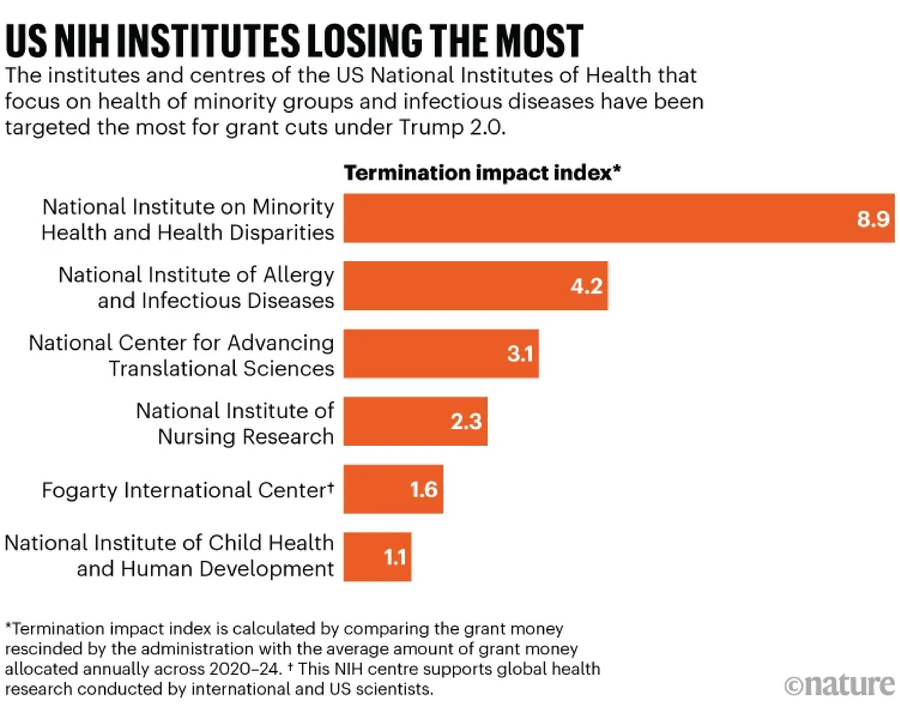The US National Institutes of Health (NIH) has terminated nearly 800 research projects at a breakneck pace, wiping out significant chunks of funding to entire scientific fields, finds a Nature analysis of the unprecedented cuts.
The administration of US President Donald Trump began purging NIH-funded studies on topics that it deems problematic less than 50 days ago, continuously expanding its list to include research on topics ranging from COVID-19 to misinformation. Hundreds of the 30,000-plus scientists funded by the NIH yearly have been forced to halt their work after receiving notices that their research “no longer effectuates agency priorities”, and some have had to fire personnel or even shut down their laboratories.
To understand the extent and breadth of these actions, which have so far clawed back more than US$2.3 billion allocated to US researchers, Nature tapped into a scientist-led effort to track these cuts (see ‘How Nature analysed NIH’s grant terminations’ in supplemental info). Our analysis reveals the project topics, NIH institutes and US states affected the most.
On supporting science journalism
If you’re enjoying this article, consider supporting our award-winning journalism by subscribing. By purchasing a subscription you are helping to ensure the future of impactful stories about the discoveries and ideas shaping our world today.
The cancellations of projects, despite scientists scoring them highly during review, “tears the long-standing fabric of the government’s contract to pursue medical research that seeks to better the healthspan and lifespan for all Americans”, says Francis Collins, a geneticist who led the NIH, based in Bethesda, Maryland, for 12 years under 3 US presidents, including Trump.
The NIH and its parent organization, the US Department of Health and Human Services (HHS) based in Washington DC, did not respond to Nature’s queries about the terminations or scientists’ concerns about them.
Grant assessment
The NIH is by far the world’s largest public funder of biomedical research, with an annual budget of US$47 billion paying for more than 60,000 grants. This size means that the agency’s funding is irreplaceable for science, says Shirley Tilghman, a molecular biologist and former president of Princeton University in New Jersey.
Nature’s analysis shows that, looking at just the projects terminated so far, 17% are related to COVID-19, and 29% to HIV/AIDS (see ‘Terminated grant tally’) — although this represents less than 4% of all the grants awarded to each of those topics that the agency funded in 2024. One reason for the focus of these cuts is that the Trump administration has said that the COVID-19 pandemic is over and people in the United States have moved on from it. Another potential reason is that HIV/AIDS disproportionately affects sexual and gender minorities (LGBT+); Trump signed an executive order on his first day in office on 20 January, directing the US government to stop acknowledging the fact that a person’s gender can differ from their sex at birth.
The scientific fields hit hardest by the NIH’s cuts are those related to the health of transgender people, and the broader LGBT+ community, where around half of grants have been cut compared with what the NIH funded in 2024 (see ‘Fields under fire’).

These actions deny “a small but real percentage of the population answers to critically important questions about their health”, Tilghman says. “You cannot eliminate a segment of the population by executive order, but you can harm them greatly.”
The NIH institutes that fund a lot of research in these now-disfavoured topic areas — for instance, the US National Institute on Minority Health and Health Disparities — have been hammered by the cuts (see ‘US NIH institutes losing the most’). Five of six of the directors of the NIH’s institutes and centres affected the most by these grant cancellations were placed on administrative leave last week, amid a glut of lay-offs and restructuring at the HHS.







